Non-timber forest products (NTFPs) play an important role in both national and local economies. In some cases, the importance of these activities can be seen clearly from national statistics. In India, for example, more than 30 million people are employed in the non-timber forest product sector. In central Java in Indonesia, wood carving represents roughly 75 percent of handicraft exports. Products like rubber are critical to the economies of many countries. National statistics do not tell the whole story, however. Products that hardly figure in the statistics may nevertheless play an essential role in maintaining livelihoods at the local level. In Channapata, a town in Karnataka state in India, some 35 percent of employment comes from the lacquerwork industry. In Sahelian villages such as Samkedji, Senegal, families survive the hungry season by selling kinkiliba, a kind of wild tea that grows on common lands around the village.
NTFPs can also play an important part in the sustainable management of forests. The value of timber depends on cutting trees. While this can be done in a sustainable fashion, often the fastest profits are obtained by clear-cutting which decimates a whole range of forest resources. In contrast, the exploitation of many NTFPs depends on keeping forests intact. In many places, if the full range of NTFPs is extracted and marketed, forests can provide much greater economic benefits than when they are used exclusively for timber. In cases where the value of NTFPs is well recognized, there is a powerful incentive to maintain standing forests.
The markets for NTFPs vary enormously. Some markets, such as the bidi cigarette market in India, the rattan market in Indonesia and the Brazil nut market in Brazil, are extremely well organized. More commonly, however, the markets for NTFPs are informal and unstructured. While the immense variety of NTFPs makes generalization difficult, these products often share at least some of the following characteristics.
The raw materials for NTFPs are often gathered from qovernment owned or communal as opposed to private lands
This includes such products as honey, game meat, liana vines and grasses. Tenure systems on these lands may be more complex and the rules of access less clear than on private lands. This may result in conflicts between users and make planning for the sustainable management of resources more difficult. In addition, if users fear that they may lose access to the forest, they will be less likely to invest in the resource and to monitor and control harvesting. Because the harvesting of certain forest products is illegal on some public lands, it may be particularly difficult to obtain valid information about the collection and use of these products.
NTFPs are often seasonal.
Many NTFPs, such as mushrooms and nuts, are seasonal and depend on natural growth and regeneration, which makes their productivity unpredictable. Prices may vary over the course of the year in reaction to seasonal changes and will also vary between years depending on nature's bounty. The income of collectors and processors tends to be similarly variable. The seasonality of these products can also be an advantage. Many NTFPs are available during the non-agricultural season. Exploitation of these products can complement farming activities and fill gaps in the household income flow.
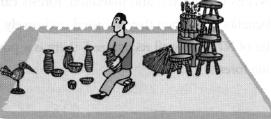
Producers are frequently rural people and often poor or landless. Production is frequently small scale
NTFPs often provide income to people with limited alternative employment opportunities and low income. Products on communal lands are particularly important to the landless. For many forest products, the skills and tools required for collecting, and even for processing, are low, making the enterprise attractive to poorer people.
The percentage of the final sale price for a NTFP received by the local-level collector, producer or processor is frequently extremely small
The profitability of enterprises based on NTFPs is often low. Some of the reasons that individual producers receive such a small percentage of the total profit on NTFPs are: trading is done individually; producers are unorganized and dispersed; individuals lack the necessary marketing skills and information to gain leverage in the market; and individuals lack related business assets such as storage and transport.
Information on the exploitation of NTFPs is often lacking
Foresters who are trained in timber management frequently lack training and experience with NTFPs. Research in these areas has generally focused on only a few products that are important on the international market (such as rubber). Often there is considerable local indigenous knowledge concerning the production and management of NTFPs, but there are sometimes gaps in this knowledge as well. It is therefore particularly important that the design of strategies to exploit NTFPs be a collaborative exercise that makes full use of local people's knowledge as well as the expertise of outside professionals with relevant experience.

Many NTFPs have only weak links to official marketing systems
Since NTFPs are often sold in informal markets, information about prices, product flow and marketing options is less well known than for major crops or for timber. Foresters whose training is largely technical and oriented to production issues may know little about the economics and marketing of NTFPs. However, the absence of formal marketing channels can also be an advantage, since it is easier for small producers to gain access to these markets, and regulations are often less onerous than in government-regulated markets.
While these characteristics are common to NTFPs, many other village-level enterprises share similar characteristics. Once local producers master the principles of setting up an MIS for NTFPs, they can, and probably will, apply the system to other local products. In several of the test sites, participants decided to use the system to track prices for NTFPs plus other goods that were particularly important to them.
As described in the definitions above, marketing information is all the data that can help those involved in production and sales identify and meet clients' needs. Marketing information is critical to the success of any business since, in order to market goods or services effectively, the seller needs solid information about what the buyer wants. Similarly, to ensure that the most effective production and distribution methods are being used, producers need to know what their options are.
Marketing information makes the market more transparent so that business people can make informed choices about production and sale. The illustration on p. 14 shows how transparency will differ for each person in the marketing chain. Often, each person has information only about the part of the chain that concerns him or her directly. The producers described here are responding relatively passively to the demands of the market.
There are many types of marketing information that can be useful in business decision-making (see box on p. 15). Which kind of information is the most important will depend upon local needs and priorities and the user's position in the marketing chain.
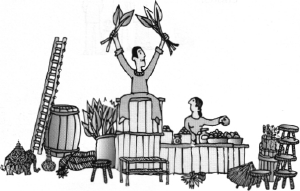
 PRODUCER - I carry my lianas that I collect
in the forest to the roadside where I sell them to a passing trader. He pays me
about $1 per bunch. I do not know where he goes with the product after he buys
it from me.
PRODUCER - I carry my lianas that I collect
in the forest to the roadside where I sell them to a passing trader. He pays me
about $1 per bunch. I do not know where he goes with the product after he buys
it from me.
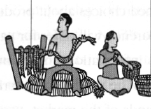 LOCAL TRADER - I purchase the lianas along
the roadside. I clean and sort them by quality, store them until the price seems
high, bring them to the market and sell them for between $1.25 and $2.00 per 5
piece bunch.
LOCAL TRADER - I purchase the lianas along
the roadside. I clean and sort them by quality, store them until the price seems
high, bring them to the market and sell them for between $1.25 and $2.00 per 5
piece bunch.
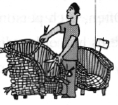 TRADE/PROCESSOR - I purchase the lianas of
different qualities, particularly when they are abundant, so I can pay a lower
price. The lowest quality is made into baskets and mats for local sale. The
higher qualities are used to make furniture for export. My sale prices vary
based upon market, quality, colour and product.
TRADE/PROCESSOR - I purchase the lianas of
different qualities, particularly when they are abundant, so I can pay a lower
price. The lowest quality is made into baskets and mats for local sale. The
higher qualities are used to make furniture for export. My sale prices vary
based upon market, quality, colour and product.
 EXPORTER - I purchase woven furniture for
export. I buy only the highest quality and sell it to buyers for upscale
furniture stores which sell items for $400 to $1500. 1 generally pay between $60
and $150 per piece to which I add the costs associated with transport, marketing
and running the business.
EXPORTER - I purchase woven furniture for
export. I buy only the highest quality and sell it to buyers for upscale
furniture stores which sell items for $400 to $1500. 1 generally pay between $60
and $150 per piece to which I add the costs associated with transport, marketing
and running the business.
Producers can be more proactive, learning more about what happens to the lianas after they are sold. If they know, for example, how lianas are used and what determines good quality, they might be able to improve the quality of their product and argue for a higher price. Alternatively, if they know that the price varies according to the time of year, they might be able to organize the storage of the product locally until the price rises, thereby gaining more profit for their efforts.
EXAMPLES OF THE KIND OF MARKETING INFORMATION AN MIS CAN PROVIDE
MARKETING INFORMATION |
MARKET INFORMATION |
• Product characteristics: size, shape, colour, volume, quality and packaging of various products for different markets. |
• The markets that exist for products. |
• Place and distribution channels: names and schedules of markets, traders, wholesalers, retailers, cooperatives and marketing boards. |
• Levels of demand and supply, including seasonal variations. |
• Promotion alternatives: product samples, displays, fairs and advertising. |
• The size of markets. |
• Prices: various products at farmgate (e.g. local traders), retail (e.g. village markets) and wholesale outlets (e.g. canning plants); over time (to show seasonality and trends) by grades and quality. |
• Ultimate product users. |
• Payment alternatives: barter, credit, cash, labour |
A Marketing Information System (MIS) is a structured approach to collecting, analysing and communicating information about markets and marketing. It should increase market transparency for users and enable them to make more informed production and marketing decisions.
Users who implement a Marketing Information System should find that they are better able to:
Ultimately, as users gain more information and learn how to exploit that information they should find ways to increase the profitability of their enterprise.
An MIS can organize the collection, analysis and dissemination of many different types of marketing data. This is particularly relevant when monitoring information that changes frequently, such as prices, since this is where local producers often have the most difficulty. It is not necessary to monitor prices that are known to remain stable, although participants may want to identify these in their initial situational analysis.
There are unlimited possibilities for the kind of information that can be gathered by a group setting up an MIS. Information collection and analysis implies certain costs, however. Visiting buyers and interviewing them about prices, whether in local markets or farther away, takes time. There also may be costs involved for transport to gather information in more distant markets. It is therefore very important that groups setting up an MIS give careful thought to what kind of information will be most useful to them and focus on the information that is most likely to increase the profitability of their enterprise. This information should be tailored to the specific circumstances of the group that is collecting it. For example, there may be no use in collecting information from a distant market during the rainy season if the state of the roads makes access to that market virtually impossible.
Participants in an MIS need to take the time to think about what information is really needed and carefully weigh the benefits of having more information versus the cost of collecting it.
When working with a group of people producing goods for sale, it will often be relevant to start with an MIS that gathers information on the prices being paid by consumers (or traders) for the goods MIS participants sell. In most cases, this kind of information is readily accessible, data collection is relatively straight-forward, and analysis is not very difficult. Most important, once the information is gathered, it can usually be put right to use and the participants can see immediate benefits from their efforts. Such a system introduces the MIS concept to the community, demonstrates its utility and galvanizes interest. Once this has been accomplished, it is easier to introduce greater complexity and to consider gathering different kinds of information that will help community members further refine their marketing strategies. The Philippines case described in the text boxes is an example of this kind of price monitoring system.
When setting up an MIS with traders who are intermediaries for goods produced by others, a useful approach could be to start by gathering information on consumer preferences. Traders need to know what consumers look for in a product so they can place orders with producers, manage stock and set prices. An MIS that tracks the kind of goods that are being sold offers a simple introduction to the value and operation of an MIS. The text boxes about the Uganda MIS offer an example of how small-scale traders established an MIS to collect this type of sales information.
Data gathered in an MIS can have many different uses, depending on the needs of the participants. As suggested above, a common MIS activity involves collecting information on the price of a given product in several markets. Such information can be collected by volunteers from the group on a weekly basis. This kind of information can be used in several different ways. It can be posted in a central place so that each week individual producers can determine, the most profitable outlet for their goods. As information is gathered over the course of a year, it can be compiled on a price calendar. This permits participants to begin analysing the best time to market their goods and to calculate whether there might be benefits in storing some products while waiting for the price to rise. When the same kind of data is gathered for several different goods, participants can use the information to analyse which product provides the best returns. Some other possible uses of MIS information are listed in the box below.
An important step in designing the MIS is determining how to present the information that is collected since this will influence its interpretation and use. A large blackboard where price monitors write down the price for different markets on a given day each week may be all that is needed for sellers to decide where to take their produce. If the information is to be used to highlight changes in prices over time, it is generally more effective to draw trend lines reflecting rising and falling prices. Each market surveyed may have its own trend line to show how prices in that market varied over the year. Later, the lines can be compiled on a large sheet of paper to facilitate a comparison of prices over time in different markets.
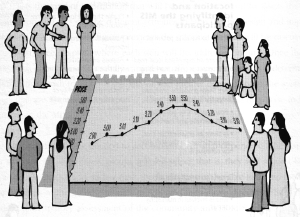
Users of marketing information systems identify different benefits depending on the nature of the group and the marketing problems they face. In Uganda, handicraft sellers surveyed market preferences and found that Ugandans prefer brighter colours, while tourists selected more muted designs. With this information they were able to segment and target certain portions of the market. In the Philippines, by monitoring prices in several markets, sellers were able to direct their produce to markets where prices were higher at a given point in time. Even those sellers with established relations with individual buyers (suki) found that they were able to negotiate better prices because they were informed of the larger market context and not so dependent on information provided by the seller. As one participant noted, "The system helps assure that we do not cheat each other". Several of the groups using MISS have found that when they organized to collect marketing information, they also found other ways to collaborate. As a result, their groups became more dynamic and cohesive. For example, while researching prices in different markets, members of a group in the Philippines identified a transportation bottleneck. As a result, they were able to work out a cooperative system to transport and sell their pineapple harvest.
Figure 1: Three steps in the development of an MIS
STEP III | ||
Designing and implementing the MIS | ||
STEP II |
||
Assesing the local situation |
Steps to put an MI5 in place: | |
STEP I |
- Choose the objectives of the MIS | |
Selecting the MIS location and identifying the MIS participants |
Ways to collect background information in the initial assessment: |
- Select the information the MIS will Provide |
- Profile the local forest and tree product economy |
- Decide which information sources will be used | |
Criteria to evaluate potential sites: |
- Assess marketing knowledge an interest |
- Decide how to organize the collection and analysis of data |
- Is there an expressed local need and intereet in using marketing information? |
- Assess organizational structure and management capacity to carry out an MIS |
- Choose how to communicate the results |
- Are there products produced above the subsistence level? |
- Determine availability of marketing information and assess its quality |
- Design training activities |
- How easy is it to get data about markets and marketing? |
- Establish a monitoring system | |
- Is there an organization that can participate in the MIS and how cohesive is it? |
- Anticipate the MIS evaluation | |
Criteria to identify the MIS target group: |
||
- Who is involved in marketing NTFPs? |
||
- Who has expressed an interest in improving the marketing of NTFPo? |
||
- Who lacks marketing information and could benefit most from using an MIS? |
While every MIS will differ in its details, in general there are three steps in setting up an MIS.
Step I: |
Select the MIS location and participants |
Step II: |
Assess the local situation |
Step III: |
Design and implement the MIS |
Figure 1 lays out the three steps and notes the specific activities carried out in each one. It summarizes the criteria that might be used to select the sites in Step I, lists the kind of information that will be needed in Step II to assess the local situation and lays out the different activities in Step III, the design and implementation of the MIS. The figure previews the information that will be discussed in the next three chapters where each step will be addressed in turn. Once these three steps have been successfully carried out, the group members will determine whether they wish to expand the MIS or add greater complexity to the system, issues that are discussed in chapter 6 along with problems that may arise in implementing the MIS.
The amount of time needed to accomplish each step depends on the particular situation. In some cases, groups will self-select; that is, they will request help for a specific purpose. In such a case, the facilitator may be able to assess the appropriateness of the group's request rapidly and then move directly to Step II to begin a participatory assessment of the community and its MIS needs. In other cases, the community may not be aware that assistance with an MIS is even a possibility. In this case, the facilitator would have to gather quite a bit of information in Step I in order to determine whether a particular community would benefit from MIS activities. The facilitator could then propose an MIS to the group and, if the suggestion were well received, begin working with the population to carry out an assessment of needs and the local situation.
The needs of different communities will vary enormously. The facilitator should take care not to underestimate the amount of time that will be needed at the beginning to help most communities get an MIS started. In the Sta. Catalina case in the Philippines, the facilitator and a colleague together estimate that they spent 50 days working with the community during the first six months that the MIS was being planned and implemented.